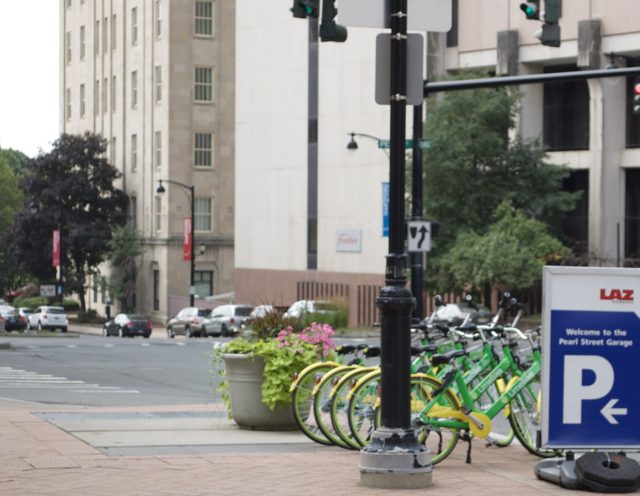
Lime‘s bike share program has been operating for a few weeks now in Hartford, yet misinformation remains abundant. Here are some of the sentiments we’re hearing, accompanied by corrections and commentary.
THE BIKES ARE NOT IN DOWNTOWN. I SAW BIKES OUTSIDE OF HARTFORD!!!
It was never the purpose of this bike share program to provide bikes solely for use in the central business district.
In the past when other bike share programs were floated out as mere ideas, proponents called to install rental areas in Bushnell Park, with the thought that tourists would ride around in the park.
Thankfully, Hartford went in another direction.
For now, there are no geographic limits on Lime rentals in Hartford.
For now.
The company is looking at patterns of organic use to determine where those future restrictions may be placed. In the meantime, bikes that venture far from Hartford or sit too long in one spot are being collected and redistributed by Lime employees.
How? All the bikes are equipped with GPS. Regular folk can only see available bikes in the app, but employees have access to the locations of all Lime bikes in the system, minus the few that have had the GPS illegally removed.
Because it takes a village, people report when they notice a damaged or misused bike. Crew members retrieve those bikes, which have a remote alarm system that can be activated by Lime to basically irritate someone who, for instance, is hoarding a rental bike in his house rather than parking it in the public right-of-way.
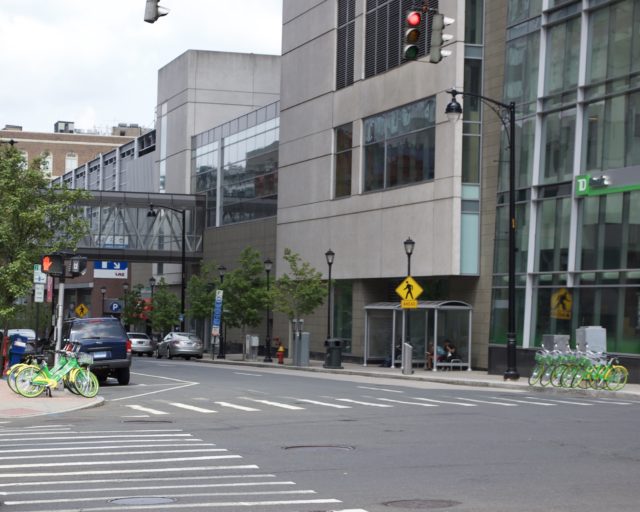
KIDS ARE ON THE BIKES
Youth who are 16+ may ride the bicycles with parent/ legal guardian supervision. The kiddos need to wear “Snell, CPSC, ANSI or ASTM approved helmet that has been properly sized, fitted and fastened according to the manufacturer’s instructions at all times while riding.”
While young people riding Lime bikes without supervision does break the rules, this needs to be viewed in a larger context. The reality is that elementary school kids have been spotted riding motorcycles, without helmets or any other gear, and without adult supervision in Hartford. Children make plenty of bad decisions — some fatal — in the absence of responsible adult guidance.
Instead of taking a punitive route regarding youth on bikes, a little advice about smarter riding could go a long way. It used to be that public schools taught basic pedestrian and cyclist safety. Does this still happen?
We should encourage young people to be responsible while they’re opting for active recreation.
THE KIDS ARE DOING WHEELIES
First of all, Lime bikes are heavy. Props to anyone who has developed the muscle needed to pull off such maneuvers.
The user agreement does forbid “” and it is worth thinking about why. On the one hand, there is always the worry/obsession with liability. On the other, which is more practical, rougher riding means breaking bicycle parts more quickly. Who wants to be replacing busted kickstands constantly? This means fewer bikes in circulation while repairs are being made.
A person who is alert and agile can probably pop wheelies and not wreck a bicycle. This might be an area in which we save our concerns for those doing crazier things on bicycles.
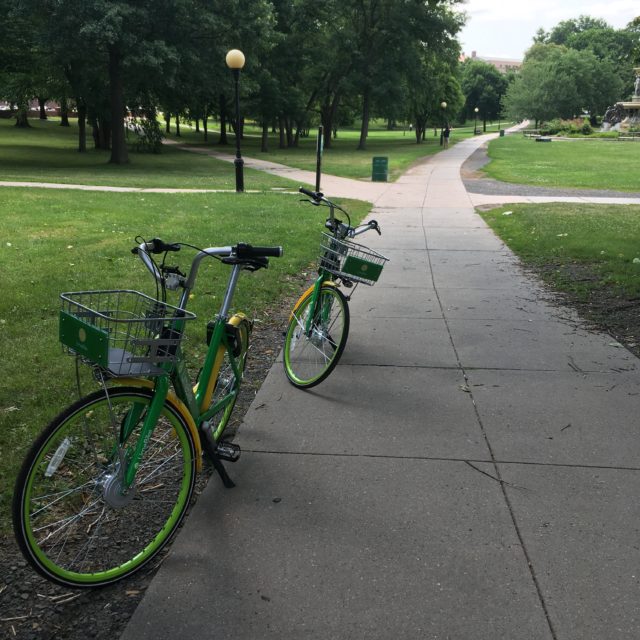
THE BIKES ARE LEFT ALL OVER THE PLACE
If you pay attention to how many people leave their personal bikes — unlocked and flat on the ground, flipped upside down, or leaning against walls — this learning curve is unsurprising. Look at how people park cars both on city streets and in lots. Will someone who parks across two spaces going to be more considerate when parking a bicycle?
Lime bikes should be parked in the public right of way where they will not interfere with access. Not all are parked neatly. Some tip over if parked on an uneven surface, of which Hartford has many.
In the first couple of weeks, I moved a handful of bikes so that they were parked correctly. This was literally only a few seconds out of my day. As the weeks went on, I have seen fewer and fewer bikes parked wrong. Either people are learning or more in the community are helping to neaten things up.
This seems like a case of seeing what one wants to see. Most Lime bikes are parked more-or-less correctly — not thrown down or blocking sidewalks.
THE BIKES ARE BEING TRASHED AND VANDALIZED
Pictures and think pieces about Lime bikes submerged in water have been posted around on social media. None of these photos were taken in Hartford, but some have presented the images as if that were the case. I still wonder what is the purpose of this, as those with the company and anyone who has done behind-the-scenes work to get bike share here are fully aware of the issues other cities have had. It’s one of those times when sitting down with employees would shed light on how the company has learned while doing, which is very different from a situation where the same exact mistakes are made again and again due to inflexible thinking.
Yes, a rope with grappling hook is a standard issue supply for cities using bike share, but how is it that posts trumpeting the downfall of dockless bike share get disseminated with gusto, yet those same doomsayers largely ignore the problems of the status quo?
It’s sloppy logic.
Why would we expect people to treat bicycles wildly different from how they use cars?
[Some, not all] . . . People steal cars. They vandalize and abandon them. They strip ’em for parts. People drive cars into waterways, including the Connecticut and Park Rivers. They drive into buildings, such as the Butler-McCook House at Capitol and Main, and the one at Albany and Main. The frequency with which people drive into drugstore buildings has become something of a sad joke. Folks crash cars into other cars, along with cyclists and pedestrians. They park the cars on sidewalks, across crosswalks, and in front of fire hydrants. They ignore signs directing them where to park and then complain when there are consequences. They race their cars against others on the streets. They do burnouts with their cars. They text and drive. They operate cars while intoxicated and/or under the influence. They operate cars when too tired. People do not properly secure loads. They transport children who are not restrained. People weave their cars dangerously, ignoring stop signs and red lights. People idle their cars, allowing for asthma-triggering pollutants to spew forth. Some use their cars to transport narcotics. According to the CDC, motor vehicle crashes are the third leading cause of Traumatic Brain Injury-related deaths, but nobody outside of NASCAR wears helmets while driving.
If we want to talk about the nice things we ruin for ourselves, there is no reason to look beyond how we interface with cars.
It is unfortunate that some people have chosen to abuse the rental bikes, but we should maintain perspective on the situation. Bike share is not the problem, nor is it a special case that inspires bad behavior. Some people in our community do not respect property or other people, or simply do not use sound judgement.
Word does get around, and more people are starting to understand that if we break our toys, we will not have any more toys to play with. There are lasting impacts to actions like overloading baskets (only rated up to 15 pounds) or bikes (rated up to 300 pounds). The couple of bikes that have been repainted silver and gold, or have had their locks removed, will likely have consequences for the vandals. The app no longer allows free first rides in Hartford unless the user has linked his credit or debit card accounts.
IT’S A GOVERNMENT BIKE / THE CITY’S WASTING MONEY
No tax dollars are going into this program. Lime needed to have the City of Hartford’s blessing to operate here, but public money is not being spent on these bicycles.
The bikes are not hand outs. They are not free.
IT’S MY BIKE. THIS BIKE BELONGS TO MY FRIEND
People have actually said this, and it’s absolutely false.
When you go to the library and borrow a book, that book is temporarily in your custody. You agree to keep the book in decent shape and return it when you are finished. It is a shared good and others are waiting to read it. When you get a bus pass, you do not own a seat on the bus; you get to rent that seat for the duration of a trip. You do not get to sit on the bus indefinitely.
Something has gotten lost in translation when it comes to the bicycles, but the deal is that they are rented per ride. The maximum ride time is 24 hours. An account is linked and the user is getting charged for the time that the bicycle is unlocked. If people are hoarding Lime bikes, they are preventing others from having access.
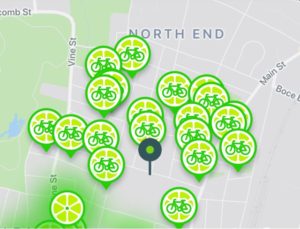 THE BIKES JUST SHOULDN’T BE ALLOWED IN SOME NEIGHBORHOODS
THE BIKES JUST SHOULDN’T BE ALLOWED IN SOME NEIGHBORHOODS
You would think there’d be less pearl clutching outside the Gold Coast.
A problem with docked bike share is that investors place stations in more affluent areas, cutting off access for those who would most benefit from having another way to get to their jobs. The intent may be to eventually expand into working class neighborhoods, but we know that when something is not prioritized, it often never happens.
Seeing Lime bikes in the neighborhoods means greater equity. It shows that this system is working.
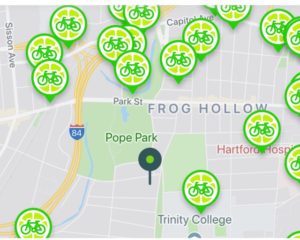 IT’S GENTRIFICATION
IT’S GENTRIFICATION
The worries about gentrification and displacement seem overblown. Would moldy mattresses and other bulky waste litter almost every street in the neighborhoods if Hartford were quickly gentrifying?
A look at who is using the bikes — not necessarily just who is documenting their use via selfies on social media — shows that these are Hartford residents. Observing where the bikes circulate reveals that many make it far outside the central business district.
What dockless bike share does is enable access to jobs for those who find themselves stranded by a public transportation system that can be unreliable and infrequent. If you miss your bus that comes only once every hour, renting a Lime bike is a lot cheaper than calling a cab.
The standard rental rate gets expensive quickly, but the Lime Access program provides 100 30-minute rides for $5 to those who qualify for state or federal assistance. It makes sense that those who can afford to pay more, do.
Hopefully this addresses most of the rumors

Tim
Thanks for this. I do not own a smartphone so will not be a LimeBike customer myself. Despite that, I think they’re great and love seeing their rapid adoption in Hartford (and slightly beyond).
I too have seen parked bikes sit for a few days in an off-the-beaten path or “hidden” locations from time to time and wondered if I should contact the company. Is there a way of reaching out to the Hartford LimeBike crew? The company website only provides a national number. In fact, Hartford isn’t even listed as a LimeBike location on their site.
LimeBikes in Hartford are enlightening and challenging many of us to re-adjust some of our assumptions and correct prejudices about who participates in new technology adoption. Your piece contributes to this process.
Tony C
Tim – Those that apply for the LimeAccess program can use a text phone (non-smart phone) to unlock bikes. Not sure if that is low income only. There are a few folks who by choice still don’t have a smart phone or data plan. https://www.limebike.com/community-impact
Kerri Provost
You can call or text that national number & leave a message with the location of the bike. It gets passed along to the local people. I’ve used it… it works.
Tom
This is a thoughtful and refreshingly level headed post. Good to see Real Hartford once again keeping it real. I was surprised by the level of pearl-clutching and scorn that greeted the program and am delighted to see some pushback to that nonsense.
Linda Pagani
I think it’s a great service, but I’m concerned for the safety of all the lime bike users riding on car-centric city streets without helmets. I don’t expect the company to provide them, but it’s not the safest situation as it exists.
Julie
I agree. I also think that the only way cyclists will become safer (like having more decorated none lanes and paths) is for cyclists to become a visible part of our community. It’s much easier to “look out for bikes” if they are seen commonly.
Additionally, one of the points in this article is that safe riding needs to be taught. Humans in Hartford and the surrounding areas do not always seem to know what the laws are. This is true for cyclists, pedestrians jay-walking, drivers… People need to learn what the rules of safe co- traveling are. This could be taught in schools, but what if you missed that day? Or what if you moved here after it was taught. It take a village. Presence helps influence change for safety.
Greg Secord
Thanks for sharing so much info about Lime bikes, great service for the community!